Ray Optics and Optical-Test Papers
CBSE TEST PAPER-01
Class - 12 Physics (Ray Optics and Optical Instruments)
According to Cartesian sign convention the heights measured
- leftwards with respect to x-axis and normal to the principal axis (x-axis) of the mirror/lens are taken as positive
- downwards with respect to x-axis and normal to the principal axis (x-axis) of the mirror/lens are taken as positive
- rightwards with respect to x-axis and normal to the principal axis (x-axis) of the mirror/lens are taken as positive
- upwards with respect to principal axis (x-axis) and normal to the principal axis (x-axis) of the mirror/lens are taken as positive
A lens of power + 2.0 D is placed in contact with another lens of power – 1.0 D. The combination will behave like
- a converging lens of focal length 100 cm
- a diverging lens of focal length 50 cm
- a converging lens of focal length 50 cm
- a diverging lens of focal length 100 cm
Dispersion is
- The phenomenon of scattering of light from various molecules
- The variation of refractive index from glass to glass
- The phenomenon of splitting of light into electric and magnetic fields
- The phenomenon of splitting of light into its component colours
A converging lens is used to form an image on a screen. When the upper half of the lens is covered by an opaque screen
- none of these
- complete image will be formed
- intensity of the image will increase
- half the image will disappear
Total internal reflection can take place only if
- incidence angle = , = refractive index of medium 2 w.r.t. medium 1
- tan(incidence angle) > , = refractive index of medium 2 w.r.t. medium 1
- cos(incidence angle) = 1, = refractive index of medium 2 w.r.t. medium 1
- sin(incidence angle) > , n21=refractive index of medium 2 w.r.t. medium 1
What is the number of images of an object held between two parallel plane mirrors?
How does the angle of minimum deviation of a glass prism vary, if the incident violet light is replaced with red light?
Write down expression for its magnifying power.
Write the relation for the refractive index of the prism in terms of the angle of minimum deviation and the angle A of prism.
Draw a labeled ray diagram of a reflecting type telescope. Write its any one advantage over refracting type telescope.
How does the power of a convex lens vary, if the incident red light replaced by violet light?
A ray of light incident at 49° on the face of an equilateral prism passes symmetrically. Calculate the refractive index of the material of the prism.
The near point of a hypemetropic person is 50 cm from the eye. What is the power of the lens required to enable the person to read clearly a book held at 25 cm from the eye?
- Two thin lenses, both of 10 cm focal length one convex and other concave, are placed 5 cm apart. An object is placed 20 cm in front of the convex lens. Find the nature and position of the final image.
- A prism is found to give a minimum deviation of 51°. The same prism gives a deviation of 62°48' for two values of the angles of incidence, namely, 46°6' and 82°42'. Determine the refractive angle of the prism and the refractive index of its material.
CBSE TEST PAPER-01
Class - 12 Physics (Ray Optics and Optical Instruments)
Answers
- upwards with respect to principal axis (x-axis) and normal to the principal axis (x-axis) of the mirror/lens are taken as positive
Explanation: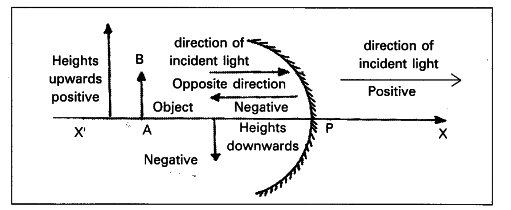

- upwards with respect to principal axis (x-axis) and normal to the principal axis (x-axis) of the mirror/lens are taken as positive
- a converging lens of focal length 100 cm
Explanation: Combined power, P = P1 + P2 = +2 D + (-1 D) = +1 D
focal length of combination, f = 1/P = 1/1 = 1m = =100 cm
Since focal length is positive, it will behave as converging lens.
- a converging lens of focal length 100 cm
- The phenomenon of splitting of light into its component colours
Explanation: In dispersion, light of different wavelength deviates by different angles, hence it splits into consituent colors.
- The phenomenon of splitting of light into its component colours
- complete image will be formed
Explanation: complete image will be formed at same position as the light rays passing from the transparent portion will still converge at the same points. But less number of rays passes through the lens, hence intensity of image decreases.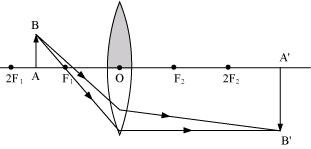
- complete image will be formed
- sin(incidence angle) > , n21=refractive index of medium 2 w.r.t. medium
Explanation: n21 = refractive index of medium 2 w.r.t. medium 1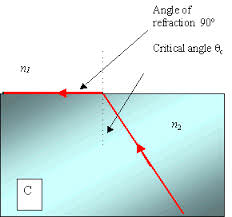
According to Snell's law,
When i = c, r = 90°
Hence sinc =
For TIR to take place, i > c hence sin i > sinc (i.e. )
- sin(incidence angle) > , n21=refractive index of medium 2 w.r.t. medium
Given
Number of images
= infinite
When the incident violet light is replaced with red light, the angle of minimum deviation of a glass decreases.Magnifying power,
The ray diagram of a reflecting type telescope is shown below:

Since a reflecting telescope has mirror objective, the image formed is free from chromatic aberration.By the lens maker's formula
Power of lens
Power of the lens will be increased.As the prism is an equilateral one, A = 60°. Since the ray of light passes symmetrically, the prism is in the position of minimum deviation.
So,
Also i = 49°
orGiven, u = -25cm, v = -50 cm, f = ?
Using lens formula,
f = 50 cm
Hence, the corrective lens is convex.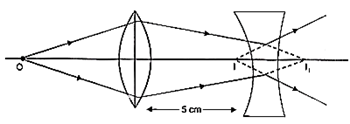
For refraction at the convex lens, we have
u = -20 cm; f1 = 10 cm; v = v1 =?
Using lens formula, we have
v1 = 0 + 20 cm
The convex lens produces converging rays trying to meet at I1, 20 cm from the convex lens, i.e. 15 cm behind the concave lens.
I1 will serve as a vertical object for the concave lens.
For refraction at the concave lens, we have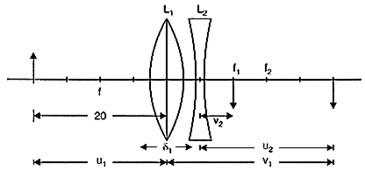
For concave lens,
u = 20 - 5 = 15 cm, f = -10 cm
As per sign convention
u = -15
f = -10
v = -5 cm
i.e. This image is in the side of object 5 cm Right to concave and 10 cm (5 + 5) from convex
u = + 15 cm v = ? , f = -10cm
Using lens formula, we have
v = -30 cm
Hence, the final image is virtual and is located at 30 cm to the left of the concave lens.The incident ray is deviated through when angle i = 40o6'. From the principle of reversibility of light, it is clear from the figure that the emergent ray (for which angle e = 82o42') is also deviated through the same angle . Now,
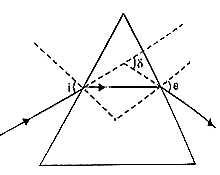
or
or A = 60°
which is the refractive angle of the prism.
For minimum deviation, i = e
Hence,
or
Which is the angle of incidence at minimum deviation? The refractive index of the material of the prism is given by
or
or